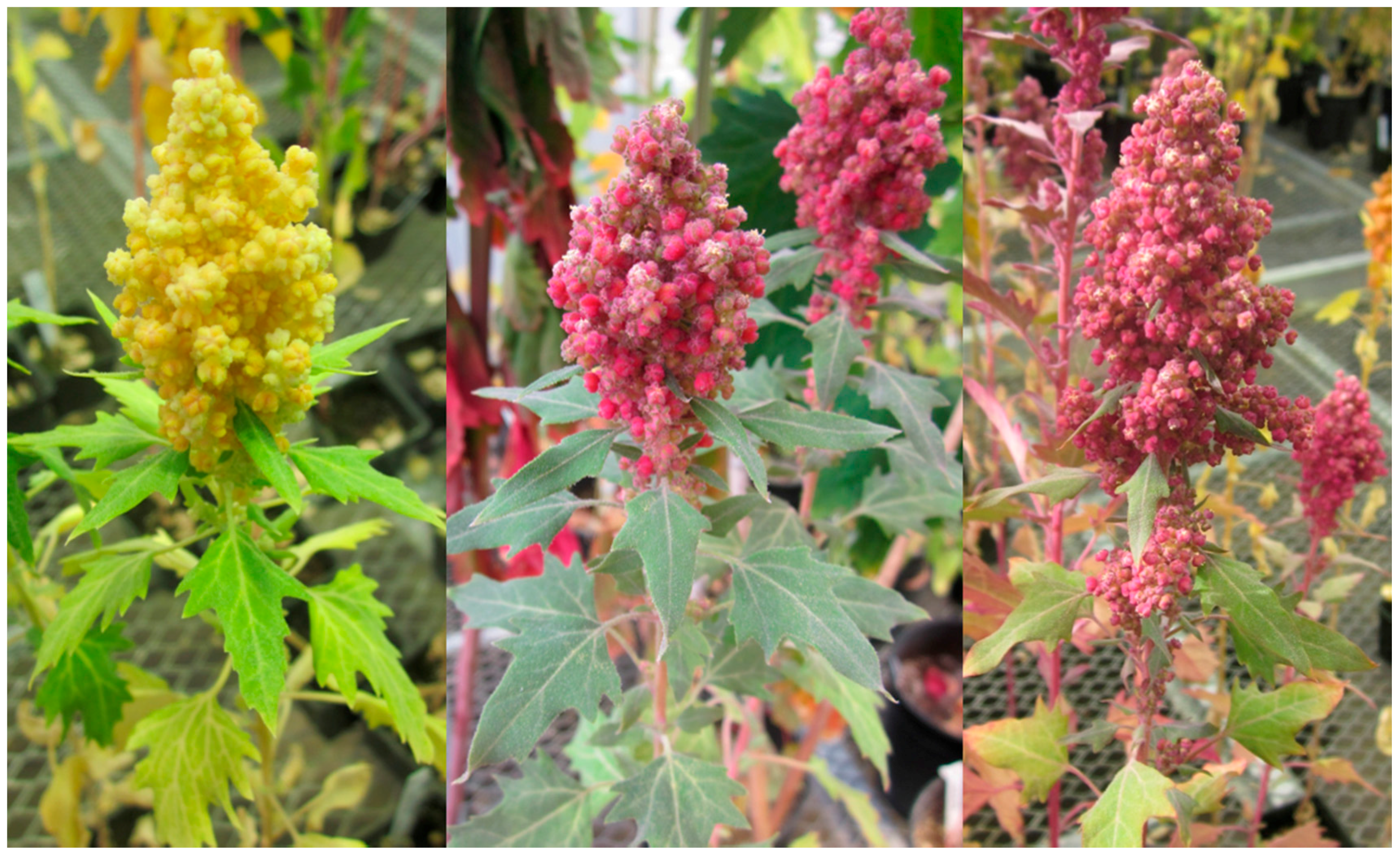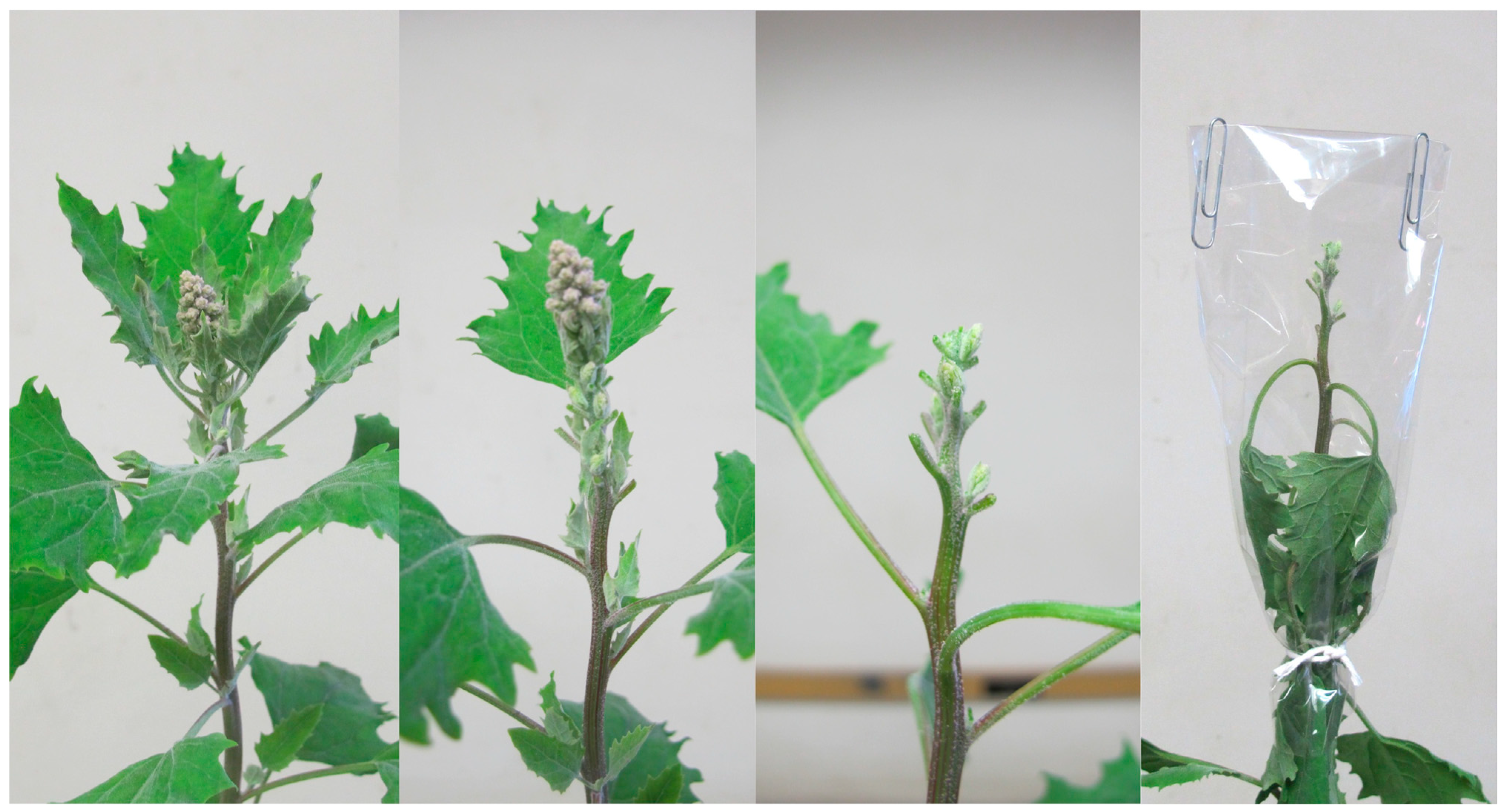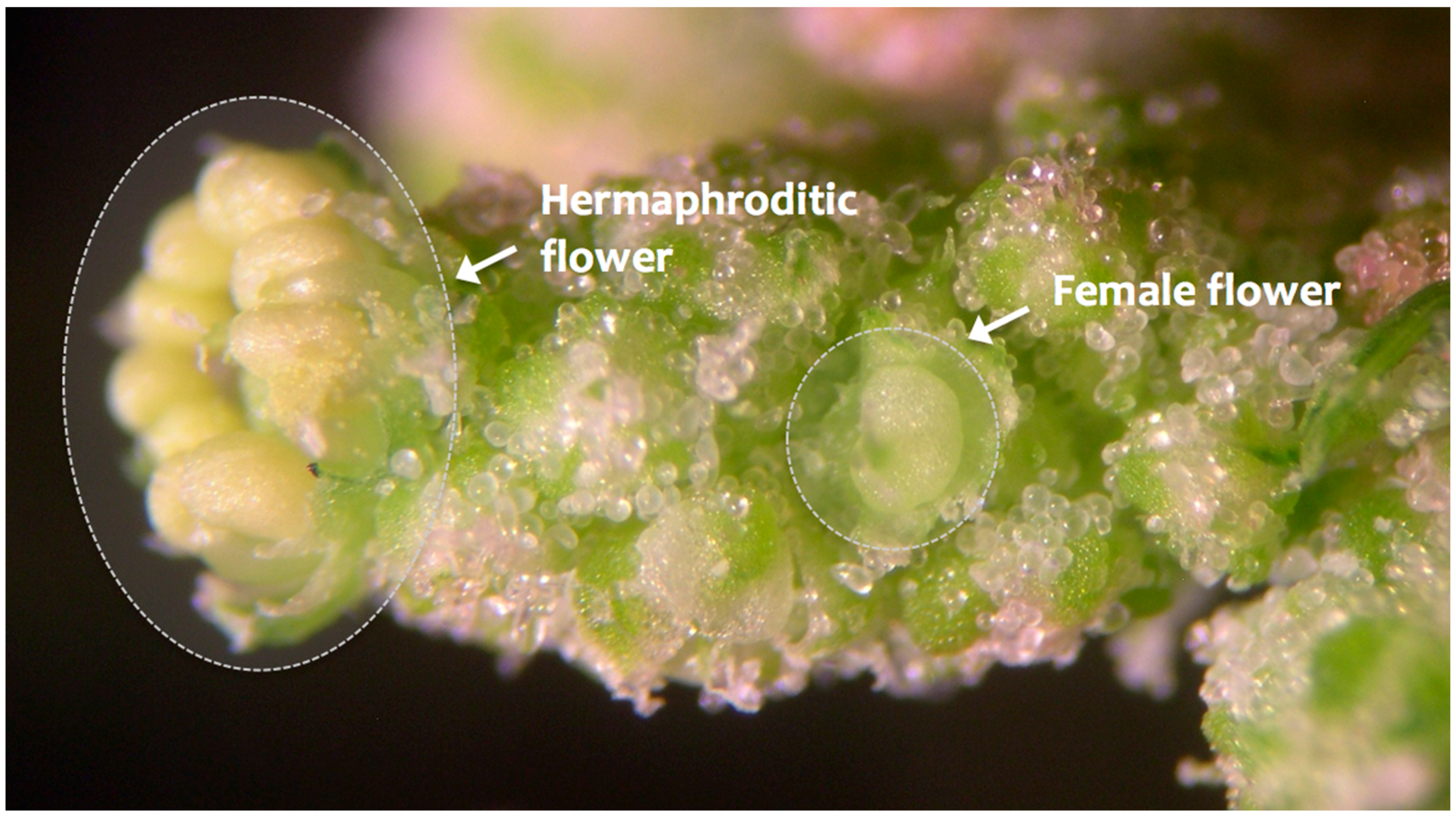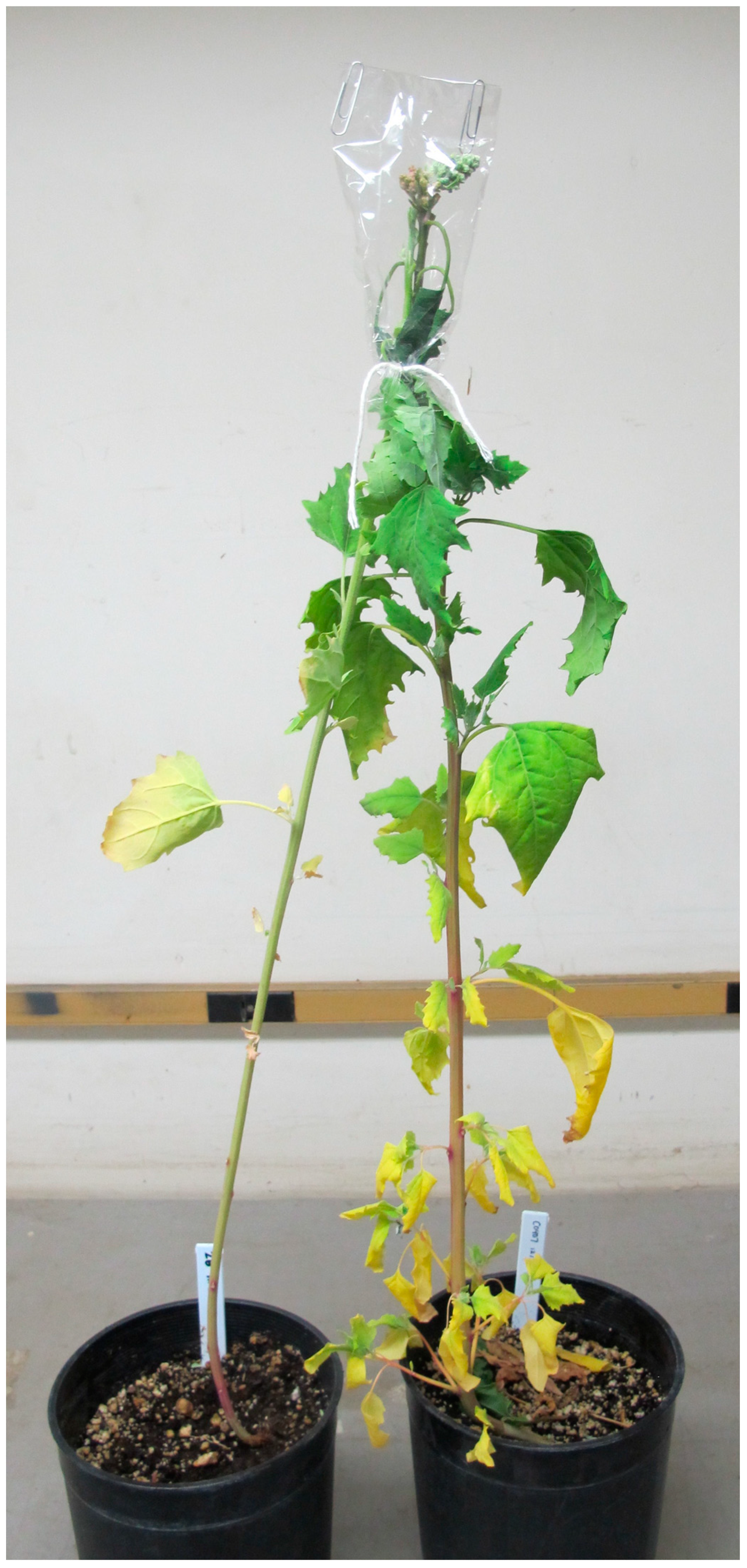1. Introduction
Interest in quinoa (
Chenopodium quinoa Willd.) cultivation has increased rapidly in recent years due to the sharp rise in consumer demand and the recognition of quinoa’s agronomic resilience and unique nutritional characteristics [
1]. Variety selection and development will be critical to the successful introduction of quinoa to novel agricultural environments.
Breeding aims for quinoa have recently been published by Zurita-Silva
et al. [
2] Formalized quinoa breeding programs were not initiated in the Andes until the 1960s, and elsewhere from the 1970s onwards [
3,
4]. Breeding efforts are currently in progress at various institutions across the world [
4].
In the United States, Washington State University is focusing on several important traits for improving and adapting existing quinoa cultivars for agricultural production. Resistance to limiting abiotic stresses, such as heat stress and pre-harvest sprouting is a central area of focus. Improvement in resistance to these factors would lead to the expansion of quinoa’s range in North America and other temperate environments, and should contribute to increases in seed yield and quality, and harvest security in its current range of production [
5].
In South America (Bolivia, Peru and Ecuador) quinoa breeding efforts have focused on developing large seeded varieties, both bitter and saponin free types, and on increasing yields. In the last decade, resistance to mildew disease and early maturing varieties have been of interest to cope with consequences of climatic changes, such as the delay and concentration of the rainy season. Recent efforts include breeding for quality traits for industrial processing such as amylose and amylopectin ratio along with white and red seed color.
The development of saponin-free cultivars containing the recessive allele conferring lack of bitter saponin production in the seeds [
6] is currently underway and could have substantial benefits by reducing processing costs. Breeding efforts in the Netherlands have successfully introduced the saponin-free trait from highland varieties into a lowland genetic background [
7], allowing for cultivation of saponin-free cultivars at temperate latitudes.
Early maturing genotypes have been developed in Denmark, providing material which can produce seed yield under long day conditions from northern to southern Europe [
8,
9,
10,
11,
12].
Breeding efforts have also targeted generating quinoa varieties with a range of seed colors, which could open up opportunities for farmers in terms of aesthetic appeal. Nutritional benefits might also be realized. Improved nutritional properties have been suggested as linked to quinoa color. For instance, red quinoa seeds displayed increased antioxidant activity compared to that of yellow quinoa seeds [
13].
A range of molecular tools have been developed for quinoa, which could play an important role in future quinoa breeding efforts [
2]. The tools may enable breeders to tackle the limitations of allotetraploidy and genetic specificities. Most recently, next-generation sequencing technology has been deployed to generate a large number of SNPs, which could allow for cost-effective marker assisted selection in quinoa [
14]. Use of molecular markers could also allow for positive identification of F
1 hybrids where a visual morphological marker is lacking.
A method for manually cross-pollinating quinoa varieties will be key in the development of improved varieties of quinoa. Quinoa is a gynomonoecious species, containing both hermaphrodite and female flowers on the same plant [
3]. Due to the abundance of small flowers, manual emasculation has proven very difficult for the crop [
15]. Other methods, such as emasculation of the inflorescence through submersion in hot water have been tested, but have proven ineffective due to damage to the plant [
16]. Doubts have also been expressed about this usefulness due to the progressive nature of flowering within the quinoa inflorescence [
17].
Male sterility appears to be the most promising alternative to manual emasculation. Multiple instances of male-sterile varieties have been identified in quinoa [
18,
19,
20]. The most suitable source for breeding purposes appears to be the cytoplasmic male sterility (CMS) found in PI 510536, for which restorer genes were found in a wide range of quinoa germplasm [
21]. However, the necessity of introgressing this CMS source into the female parent before conducting a cross significantly lengthens the time required for crossing quinoa when using male sterility, as compared to manual emasculation.
Despite the difficulty of crossing quinoa, there are a few discussions of the methods used to cross quinoa varieties through manual emasculation [
3,
17], which generally involve a similar technique of isolating flower clusters. There is currently no readily accessible detailed guide outlining this crossing process.
Based in part on the descriptions from these sources and in part from independent experimentation and continual refinement through trial and error, a crossing method was developed that has given a high rate success in hybridizing quinoa varieties in controlled greenhouse conditions.
The new crossing method has also successfully been used to generate interspecific hybrids between
C. quinoa and
C. berlandieri, and this method could be applicable to other
Chenopodium spp. that have similar flower and inflorescence morphology to quinoa. Wild relatives of quinoa have been identified as sources of valuable resources for quinoa improvement, most often for the potential of
C. berlandieri as a source of downy mildew resistance [
2,
14,
17,
22,
23,
24].
2. Materials and Methods
2.1. Materials
Equipment required for quinoa hybridization are generally low-cost and available worldwide. These materials include ultra-fine pointed forceps, a small pair of scissors, paper clips or tape, dialysis tubing or other regionally available transparent isolation bag material, a stereo/dissecting microscope, string, a notebook, and stakes (when necessary for plant support).
2.2. Parental Variety Selection
Parental selection is an important step in the hybridization process both for selecting and improving traits of interest, and for confirmation of successful hybridization. Choosing parents that differ in a qualitative morphological trait can allow for verification of successful hybridization (
Figure 1). By choosing a male parent with the dominant phenotype as the male parent and a variety with the recessive phenotype as the female parent, any successful F
1 progeny can be distinguished from plants with a recessive phenotype that resulted from unintended self-pollination of the female parent.
Readily identifiable morphological traits include seed color, inflorescence color, axillary pigmentation, and plant color. The inheritance for such traits has been determined, either fully or partially (
Table 1). In the CPRO-DLO (Center for Plant Breeding and Reproduction Research—Agriculture Research Department) quinoa breeding program in the Netherlands, inflorescence color was used to identify successful hybrids of parents differing in inflorescence color. This was done for all combinations of a pool of varieties with white, yellow, orange, pink, red, and cherry red inflorescence color. The sole exception was for progeny of a cross of a red and cherry red parent, which could not be successfully confirmed based on color [
25].
Figure 1.
Inflorescence color was used as a dominant morphological marker in a cross between Bio-bio (center) and Temuco (left). Two F1s (right) exhibit the dominant pink inflorescence color, as well as leaf morphology intermediate to both parents.
Figure 1.
Inflorescence color was used as a dominant morphological marker in a cross between Bio-bio (center) and Temuco (left). Two F1s (right) exhibit the dominant pink inflorescence color, as well as leaf morphology intermediate to both parents.
Table 1.
Inheritance of useful qualitative traits for quinoa breeding.
Table 1.
Inheritance of useful qualitative traits for quinoa breeding.
| Traits | Genotype | Phenotype | Remarks |
|---|
| Axil pigmentation [18] | Ax- | Present | Axil pigmentation cannot be distinguished on colored stems [18]. When present, axil pigmentation may be present sporadically and can sometimes be difficult to detect. |
| axax | Absent |
| Plant color [18,26] | R- | Red | Plant pigmentation when present can vary widely when present [18]. Purple color is present in salt glands on uppermost leaves and in the panicle. Red is present throughout the plant [26]. |
| rprp | Purple |
| Rr | Green |
| Saponin content [6,26] | D- | Bitter | Recessive allele alternatively designated sp1 by Ward [6]. |
| dd | Sweet |
| Seed color [26] | aacc | White | Additional seed colors exist, but their inheritance patterns are undescribed. Inheritance patterns for seed colors inherited due to gene flow from C. berlandieri have not been determined. |
| A-cc, aaC-, ac-cc, aacc- | Yellow |
| accacccc | Light brown |
| acac, cccc, ac-cc- | Brown |
| A-C- | Black |
| arar | Red |
Intermediate size and earliness of F1 plants, when present, can also be used to verify hybridization. When qualitative morphological traits are lacking in parents and hybrid vigor is not present, hybridization can be confirmed by observing segregation in the F2 progeny.
2.3. Planting
For the hybridization method described herein, quinoa plants should be sown in small pots (2-3 l) to limit plant size and make manual emasculation easier. Minimal fertilization should be applied to further restrict vigorous plant growth.
For each cross, three sets of plants of the male parent and two sets of the female parent should be sown, each set spaced a week apart. The male parents should be planted in week one, followed by plantings of both females and males in the subsequent two weeks (
Table 2).
Table 2.
Planting schedule for quinoa crosses.
Table 2.
Planting schedule for quinoa crosses.
| | Week 1 | Week 2 | Week 3 |
|---|
| Female | | Sow 3 plants | Sow 3 plants |
| Male | Sow 3 plants | Sow 3 plants | Sow 3 plants |
This temporally spaced planting design is used to ensure that receptivity of the female parent occurs when pollen is available from the male parent. Significant differences in flowering times between varieties can cause gaps between pollen receptivity in the female parent and anther dehiscence in the male parent. Additionally, the manual emasculation process can slow flower development by disturbing the natural flowering process.
This disparity in planting times is particularly notable when varieties from the Chilean lowland ecotype are crossed with Altiplano varieties, strongly influenced by photoperiod. In non-tropical locations where photoperiod varies considerably, such crosses may best be attempted during the winter months, when the necessary shorter photoperiods can be controlled by supplemental lighting. Alternatively, plants with different photoperiod responses can be grown in a growth chamber where photoperiod can be carefully regulated. Planting sets in two week intervals, additional replications, and earlier planting of the later maturing parent may also be advised.
Parental varieties can also be planted in longer intervals than seven days, and this period may be quite flexible. A longer period of 10 days between sets of parents was recommended by Bonifacio [
17].
2.4. Isolation and Inflorescence Preparation
Plants should be closely monitored as they approach the reproductive period (stage 1, [
15]). Once the flowering bud is visible on the top of the plant and is approximately 1.5 cm in size, it should be removed with scissors. This flower bud would otherwise turn into the main bulk of the quinoa inflorescence, which contains too many flowers to allow complete manual emasculation. This main flower bud is removed in order to focus hybridization efforts on the more manageable flower clusters that grow below the main flowering bud and some length down the stem from the leaf axles.
Only three to four flower clusters are retained towards the top of the trimmed plant. Flower clusters growing lower on the plant from the leaf axils should be removed to prevent accidental cross-pollination. Large leaves near the isolated flower clusters and the small guard leaves that surround the flower clusters should also be removed. This allows for easier access during the emasculation process and allows for proper space in the isolation bag (
Figure 2).
Figure 2.
Quinoa plant ready for isolation (far left), removal of large leaves near inflorescence (center left), removal of main flowering bud and leaves surrounding small flower clusters (center right), and isolation of flower clusters to prevent cross pollination (far right).
Figure 2.
Quinoa plant ready for isolation (far left), removal of large leaves near inflorescence (center left), removal of main flowering bud and leaves surrounding small flower clusters (center right), and isolation of flower clusters to prevent cross pollination (far right).
A 12 cm section of dialysis tubing is then placed over the top of the plant, with the top edge folded back and secured with a paper clip. The bottom is tied with a string, which can also be used to secure the plant to a stake in case it becomes top heavy. Care should be taken not to tie the tubing around the plant too tightly or plant damage can result. Care must be taken to ensure that the isolation bag made from dialysis tubing continues to cover the quinoa flowers as the plant continues to grow.
Covering the bud in the greenhouse may cause damage to the panicle, as temperature may increase within the bag. Care should be taken to keep temperature down, or this method can be attempted and adapted for field crossings, if conditions in the field are cooler. However, the incidence of rain and wind in the field can cause problems, making emasculation and crossing difficult, and risking broken plants due to the bag putting weight to the top.
Dialysis tubing has proven effective for isolation, although it can be quite expensive. Bonifacio [
17] recommends the use of glassine bags, and Risi and Galwey [
3] cite several methods that use greaseproof paper bags for isolation. These may offer cheaper and effective alternatives for isolation. Development of flowers might be expected to progress more slowly, however, due to the lower amount of light reaching the plants with these alternatives.
2.5. Flower Types
Quinoa flowering patterns are quite complex and there are differing classifications of flower types and arrangements [
27,
28]. However, for practical purposes in crossing, quinoa flowers can be classified into two main types: hermaphrodite and female. Hermaphrodite flowers contain a single pistil usually surrounded by five anthers, although the number of anthers can vary considerably in some quinoa varieties. Female flowers are smaller and lack anthers. Uncommonly, hermaphrodite flowers will have shrunken anthers or will contain filaments lacking anthers.
Flowers on the terminal position of flower clusters are hermaphrodite, while those on the flower cluster closer to the stem may be hermaphrodite, female, or a combination of these (
Figure 3). This appears to vary by variety; environmental conditions, such as temperature and shading; and can differ among flower clusters on the same plant. The presence of a high number of female flowers greatly aids the crossing process, because emasculation is not necessary for these flowers.
Figure 3.
Large, terminal hermaphrodite flower on end with sepals removed, making yellow anthers visible. In the middle of the flower cluster, a much smaller female flower with removed sepals is visible.
Figure 3.
Large, terminal hermaphrodite flower on end with sepals removed, making yellow anthers visible. In the middle of the flower cluster, a much smaller female flower with removed sepals is visible.
Once the flower clusters are isolated and prior to emasculation, the individual flowers should be examined to determine the proportion of flower types. This should be conducted as soon as flowers are large enough to examine and far before anthesis occurs. Organized notes should be taken for each plant on its development and referred to upon each further examination. Quinoa crossing is an involved process over the course of several days.
A dissecting microscope with magnifications ranging from 20–40× helps facilitate floral examination. Flowers are examined by gently lifting the sepals with the end of the forceps and noting the presence or absence of anthers underneath the sepals. Another way of recognizing female flowers is by their relatively small size. Any manipulation of the flowers is stressful to the flower and should be done with care; otherwise desiccation of the flower can result or flowering may be delayed.
In the extreme case, when all flowers in the flower cluster except the terminal flower are female (
Figure 3), preparation of the flower cluster consists of simply removing or emasculating the terminal flower. In some cases, female flowers will exhibit protogyny, exerting their stigmas beyond the sepals, and the female flowers can be distinguished by these exerted stigmas, which give the inflorescence a “hairy” appearance (
Figure 4). However, this situation is uncommon, and emasculation of some or all flowers on the flower clusters is usually necessary.
Figure 4.
Cross section of a quinoa inflorescence. Stigmas are visible as “hairs” emerging from flowers. Yellow, dehisced anthers are also visible on many of the terminal flowers.
Figure 4.
Cross section of a quinoa inflorescence. Stigmas are visible as “hairs” emerging from flowers. Yellow, dehisced anthers are also visible on many of the terminal flowers.
Emasculation should be done when the anthers are green or yellowish-green and relatively well developed. Emasculation too early when the flower is smaller and the anthers less developed can lead to injury and desiccation of the stigmata and the flower. When performed too late, after the anthers have matured and become bright yellow, emasculation can result in rupture of the anther during removal and pollen release inside the flower.
The general readiness of flowers for emasculation can be judged visually once the crosser has gained a sense of the stages of quinoa flower development. Flowers should appear distinct as in
Figure 5. However, if anthers are visible in the unopened flowers, the flower has already matured beyond when emasculation can be performed.
Figure 5.
Isolated quinoa flower clusters ready for emasculation.
Figure 5.
Isolated quinoa flower clusters ready for emasculation.
2.6. Manual Emasculation
Emasculation of quinoa flowers is a difficult process due to the small size of the flowers and proper technique requires practice, patience and persistence before proficiency is attained. Two primary problems can occur during emasculation that lead to flower abortion. The first is accidental removal of the pistil, which sits in the center of the flower and can be easily bumped with the forceps. The second is rough handling of the sepals, which results in desiccation of the stigma or the entire flower.
One way to prevent these is by bending the point of the forceps so they are curved downwards. The anthers are nestled within and covered by the sepals, requiring significant manipulation of the sepals when using straight pointed forceps. When using forceps with curved tips, anthers can be more easily removed by pulling back the sepals slightly, reaching underneath the sepals with the curved point of the forceps, and then pulling the anthers out. After the anther is removed, the sepal should be pushed back into the original curled position. The plant can be rotated so the anthers are approached from the outside, to prevent reaching over the central pistil with the forceps which may result in injury.
This process should be repeated for every hermaphrodite flower in the flower cluster. Alternatively, if a fewer number of F
1 seeds is sufficient and if the crosser’s technique is not yet proficient, it is advisable to trim the flower cluster back to three or four flowers partway along the flower cluster (
Figure 6).
Figure 6.
Approximate location where to cut flower clusters if the number of flowers per flower clusters is reduced.
Figure 6.
Approximate location where to cut flower clusters if the number of flowers per flower clusters is reduced.
Flowers in an individual flower cluster may vary in their relative maturity but should be emasculated on the same day, due to the impracticalities of emasculating a single flower cluster over multiple days. There is also significant variation among flower clusters in their maturity, and so flower clusters will likely be emasculated on separate days. The duration of the emasculation period can vary considerably depending on the plant, size of the flower cluster, and its rate of maturity.
2.8. F1 Screening
If conducted carefully and by a skilled crosser, a high rate of success can be expected. In any case, the F1 progeny should be screened to determine whether the cross was successful. F1 seed can be grown in small 500 mL pots to minimize room required for screening.
Any dominant traits present in the male parent should be visible in the F1 and will confirm successful hybridization. Some traits, such as leaf morphology or some inflorescence colors, will produce F1 progeny of intermediate phenotypes. It should be cautioned that many traits, such as plant and inflorescence color and leaf shape, appear to be influenced by environment. Because of this, it is advisable to plant seed from the original parents as controls alongside the F1 progeny. This allows direct comparison between the F1 and the parental varieties in the same environment.
If there are no qualitative morphological traits from the parents visible in the progeny, then hybrid vigor as compared to the parent controls can indicate successful hybridization. If not clearly visible, then seed from the progeny can be planted. Clear segregation in the F2 generation should occur if the original parental cross was successful. Given the high success rate of this crossing method when done correctly, this method offers significant advantages compared to simply pairing plants together and relying on proximity and chance cross pollination to occur.
3. Conclusions
A reliable, simple, and standardized system of hybridization, via manual emasculation, as outlined in this manuscript, will allow for adaptation of quinoa to diverse growing environments and to the challenges of climate change, as well as a wider contribution of quinoa’s agronomic resiliency to sustainable agriculture systems. This hybridization method can be performed with easily accessible materials, with a high rate of success, and can be used for both intraspecific crosses between quinoa varieties and interspecific crosses with closely related species such as C. berlandieri. Several qualitative morphological traits, such as seed and inflorescence color, are outlined and can allow for visual identification of successful F1 plants, when molecular markers are not available. Additionally, certain key traits, such as the saponin-free trait, offer significant and simply realizable improvements for quinoa cultivars in certain contexts, such as where the lack of saponin removal equipment poses a constraint to quinoa production.













